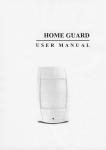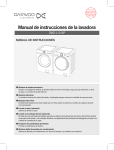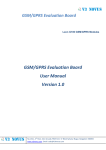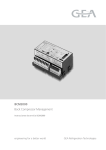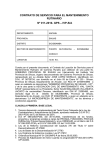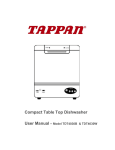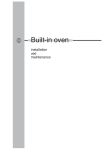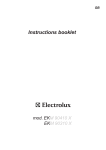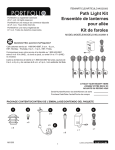Download User Manual CWB 7441 X EN ES
Transcript
Hood User Manual EN ES CWB 7441 X ENGLISH 1 Recommendations and Suggestions . . . . . . . 6 2 Warnings - Components . . . . . . . . . . . . . . . . . . . . 9 3Installation . . . . . . . . . . . . . . . . . . . . . . . . . . . . . . . . 11 4 Use - Maintenance . . . . . . . . . . . . . . . . . . . . . . . .12 ESPAÑOL 1 Consejos y Sugerencias . . . . . . . . . . . . . . . . . . .14 2 Consejos y Sugerencias . . . . . . . . . . . . . . . . . . .16 3Instalación. . . . . . . . . . . . . . . . . . . . . . . . . . . . . . . . .19 4 Uso - Mantenimiento . . . . . . . . . . . . . . . . . . . . . 20 01M-8848813200-0615-01 2 / 20 EN Hood / User Manual Please read this user manual first! Dear Customer, Thank you for preferring a Beko product. We hope that you get the best results from your product which has been manufactured with high quality and state-of-the-art technology. Therefore, please read this entire user manual and all other accompanying documents carefully before using the product and keep it as a reference for future use. If you handover the product to someone else, give the user manual as well. Follow all warnings and information in the user manual. Remember that this user manual is also applicable for several other models. Differences between models will be identified in the manual. Explanation of symbols Throughout this user manual the following symbols are used: C A B Important information or useful hints about usage. Warning for hazardous situations with regard to life and property. Warning for electric shock. Packaging materials of the product are manufactured from recyclable materials in accordance with our National Environment Regulations. Do not dispose of the packaging materials together with the domestic or other wastes. Take them to the packaging material collection points designated by the local authorities. This product was manufactured using the latest technology in environmentally friendly conditions. 4 / 20 EN Hood / User Manual Hood / User Manual 5 / 20 EN 1 Recommendations and Suggestions A The Instructions for Use apply to several versions of this appliance. Accordingly, you may find descriptions of individual features that do not apply to your specific appliance. 1.1 Installation •• The manufacturer will not be held liable for any damages resulting from incorrect or improper installation. •• The minimum safety distance between the cooker top and the extractor hood is 650 mm (some models can be installed at a lower height, please refer to the paragraphs on working dimensions and installation). •• Check that the mains voltage corresponds to that indicated on the rating plate fixed to the inside of the hood. •• For Class I appliances, check that the domestic power supply guarantees adequate earthing. •• Connect the extractor to the exhaust flue through a pipe of minimum diameter 120 mm. The route of the flue must be as short as possible. 6 / 20 EN •• Do not connect the extractor hood to exhaust ducts carrying combustion fumes (boilers, fireplaces, etc.). •• If the extractor is used in conjunction with non-electrical appliances (e.g. gas burning appliances), a sufficient degree of aeration must be guaranteed in the room in order to prevent the backflow of exhaust gas. The kitchen must have an opening communicating directly with the open air in order to guarantee the entry of clean air. When the cooker hood is used in conjunction with appliances supplied with energy other than electric, the negative pressure in the room must not exceed 0,04 mbar to prevent fumes being drawn back into the room by the cooker hood. •• In the event of damage to the power cable, it must be replaced by the manufacturer or by the technical service department, in order to prevent any risks. Hood / User Manual 1 Recommendations and Suggestions •• If the instructions for installation for the gas hob specify a greater distance specified above, this has to be taken into account. Regulations concerning the discharge of air have to be fulfilled. •• Deep fat fryers must be continu- ously monitored during use: overheated oil can burst into flames. •• Do not flambè under the range hood; risk of fire •• This appliance is not intended for use by persons (including children) with reduced physical, sensory or mental capabilities, or lack of experience and knowledge, unless they have been given supervision or instruction concerning use of the appliance by a person responsible for their safety. •• Children should be supervised to ensure that they do not play with the appliance. •• “ CAUTION: Accessible parts 1.2 Use may become hot when used with The extractor hood has been cooking appliances.”. designed exclusively for domestic use to eliminate kitchen smells. •• Never use the hood for purposes other than for which it has been designed. •• Never leave high naked flames under the hood when it is in operation. •• Adjust the flame intensity to direct it onto the bottom of the pan only, making sure that it does not engulf the sides. Hood / User Manual 7 / 20 EN 1 Recommendations and Suggestions 1.3 Maintenance •• Switch off or unplug the appliance from the mains supply before carrying out any maintenance work. •• Clean and/or replace the Filters after the specified time period (Fire hazard). •• Clean the hood using a damp cloth and a neutral liquid detergent. The symbol onthe productoronitspackaging indicatesthat thisproductmay not betreatedas householdwaste. Insteadit shalbe handed overtotheapplicablecolectionpointfortherecyclingofelectrical andelectronic equipment. By ensuringthis product isdisposedof correctly, you wilhelpprevent potential negative consequences fortheenvironmentandhumanhealth, whichcouldotherwisebe caused by inappropriate wastehandling of this product. For more detailedinformation about recycling of this product, pleasecontact your local city office, yourhouseholdwaste disposal serviceor the shop where youpurchased the product. 8 / 20 EN Hood / User Manual 2 Warnings - Components Warnings This appliance has been designed for use as either an EXTRACTION (ducting to the outside) or RECIRCULATION (filtering) hood. The measurements contained on the drawings in this booklet refer to two models of cooker hood. Therefore, it is essential that you refer to the correct drawing when taking measurements for installation. •• The minimum distance between the cooking surface and the metal grease filters on the underside of the hood must be 650mm. •• This cooker hood must be installed in accordance with the installation instructions and all requirements must be adhered to. •• If the room where the cooker hood is to be used contains a fuel burning appliance such as a central heating boiler then its flue must be of the room sealed or balance flue type. •• If other types of flue or appliances are fitted ensure that there is an adequate supply of air to the room. Hood / User Manual •• When the range hood and appliance supplied with energy other than electricity are simultaneously in operation, the negative pressure in the room must not exceed 4 Pa (4x10-5 bar). •• The ducting system for this appliance must not be connected to any ventilation system which is being used for any other purpose. •• The ducting system for this appliance must not be connected to any existing ventilation system which is being used for any other purpose. •• Do not leave naked flames or carry out flambè cooking under this cooker hood. •• This appliance is not intended for use by persons (including children) with reduced physical, sensory or mental capabilities, or lack of experience and knowledge, unless they have been given supervision or instruction concerning use of the appliance by a person responsible for their safety. •• Children should be supervised to ensure that they do not play with the appliance 9 / 20 EN 2 Warnings - Components Connecting the power cable to the mains power supply Before installation, check that the mains voltage indicated on the rating plate inside the appliance corresponds to the voltage available in your home. If the Hood is not fitted with a plug have a licensed electrician, fit the power cable with a plug of a type approved for the load indicated on the rating plate; when connecting directly to the mains, insert an omni polar circuit breaker with a minimum contact aperture of 3mm and a size suitable for the load in question between the appliance and the mains supply, making sure it is of a type that complies with current regulations. 10 / 20 EN Components •• 2 No Wall Brackets C •• 1 No 150-120mm Ducting Spigot G •• 1 No Air Outlet Connection H (Optional) •• 2 No Charcoal Filters L (Optional) Hood / User Manual 3 Installation The cooker hood must be installed centrally over a cooking appliance. The minimum distance between the cooking surface and the metal grease filters on the underside of the hood must be at least 650mm. To install the hood proceed as follows: 1. Drill six 8mm diameter holes at X1-X2-J and insert the plastic rawl plugs supplied as illustrated in fig. 2 ensuring the brackets are fitted as shown in the blow up. 2.Secure the two brackets C to the wall inserting two of the screws supplied through the two holes on line X1-X2 as illustrated in fig. 2. 3.Slide the canopy down the wall to locate the key hole over the washer then secure the canopy to the wall by inserting two of the screws supplied through the two outer holes in the rim of the canopy J1 and J2 as illustrated in fig. 3. 4.EXTRACTION OR RECIRCULATION INSTALLATION: WARNING: It is a possible fire hazard if the metal grease filters are not cleaned and the charcoal filters replaced regularly. Fitting The Chimney 5.Fitting the Chimney upper To fit the upper chimney A, place the top edge of the chimney over the bracket C as illustrated in fig. 8 and secure the chimney using two of the 2.9mm self tapping screws provided. The distance H in the height between the fixing holes X1 and X2 is determined by the height of the upper chimney A. 6.FITTING THE CHIMNEY LOWER To fit the lower chimney B, apply slight force to the two rear edges to increase the width of the apperture, then sleeve the chimney B over the chimney A as illustrated in fig. 9. EXTRACTION (DUCTED) When installing the ducted version, connect the hood to the chimney using either a flexible or rigid pipe ø 150 or 120 mm, the choice of which is left to the installer. •• To install a ø 120 mm air exhaust connection, insert the reducer flange 9 on the hood body outlet. •• Fix the pipe in position using sufficient pipe clamps (not supplied). •• Remove any activated charcoal filters. RECIRCULATION (FILTERED) •• When the hood is fitted in the recirculation mode the Air Outlet Connection H should be fitted as illustrated in fig. 6. •• Fit the (optional) charcoal filters by repeating the following operation on each side of the motor housing. Place the two key hole slots in the filter L and turn the filter clockwise to lock the filter in position as illustrated in fig. 7. Hood / User Manual 11 / 20 EN 4 Use - Maintenance Use the cooker hood functions are controlled by a series of slider or push button switches mounted on the front of the hood and control the worktop lighting and fan motor speeds. This cooker hood will not remove steam. 1) Slider switches •• A switch controls the worktop lighting - ON/OFF. •• A switch controls the fan speeds - OFF/ON-1-2-3. •• The red neon lamp illuminates when the motor is switched ON . 2) Push button switches •• A switch controls the worktop lighting ON/OFF. •• A button switches the motor OFF/ON at the low speed setting. •• A button switches the motor to the medium speed setting. •• A button switches the motor to the high speed setting. •• The red neon lamp illuminates when the motor is switched ON. 3) Speed settings •• 1 / Low should be selected when simmering or when using only one pan. •• 2 / Medium should be selected for cooking when using up to four pans. •• 3 / High should be selected when frying or cooking food with a strong odour. Maintenance N.B. Before carring out any kind of maintenance, cleaning or replacing lamps, disconnect the hood from the mains supply. 12 / 20 EN 1. Lighting Comprises two (28W - 40W) bulbs. To replace the bulbs, proceed as follows (fig.10): Remove one of the pins at the sides of the lamp cover. Slide the glass towards the side from which the pin has been removed until the opposite edge has been freed, then pull gently downwards. Replace the bults and fit the glass again by repeating the above operations in reverse order. 2. Filters •• The metal grease filter should be cleaned every two months or more frequently if the hood is used consistently and can be cleaned in a dishwasher or by hand using a mild detergent or liquid soap. When replacing, ensure that they are dry. •• The charcoal filter cannot be washed and should be replaced at least every 2 months or more frequently if the hood is used consistently. 3. Cleaning When cleaning the hood, it is recommended to use a damp cloth and mild liquid household cleaner. Never use abrasive cleaning materials. IMPORTANT: When using a gas hob in connection with the cooker hood never leave the burners of the hob uncovered while the hood is in use or when the pans have been removed. It is very important to follow all instructions for cleaning the hood and filters. There could be a possible fire hazard if the filters are not replaced according to these instructions. ATTENTION: The manufacturer declines all responsibility for any damage or injury caused as a result of not following the instructions for installation, for maintenance and replacement times of filters indicated (in order to avoid a possible risk of fire when the filters are saturated with grease). Hood / User Manual Lea el manual de usuario antes de utilizar el aparato Estimado cliente: Gracias por elegir los productos Beko. Esperamos que obtenga los mejores resultados de nuestro producto ya que ha sido fabricado con gran calidad y con tecnología de última generación. Por tanto, le aconsejamos que lea con atención este manual de usuario y todos los demás documentos adjuntos antes de utilizar el producto; guárdelo para futuras consultas. Si va a entregar este producto a otra persona, proporciónele el manual de usuario también. Siga todas las advertencias e instrucciones incluidas en este manual. Recuerde que este manual de usuario también es válido para otros modelos. Las diferencias entre los modelos se señalan dentro del manual. Explicación de los símbolos En este manual se utilizan los siguientes símbolos: C A B Información importante o consejos útiles sobre el uso. Advertencia para situaciones de riesgo con respecto a la vida y la propiedad. Advertencia para descarga eléctrica El embalaje del producto está fabricado a partir de material reciclable de acuerdo con la Normativa nacional sobre medio ambiente. No se deshaga del material de embalaje ni de los desechos domésticos o de otro tipo. Llévelos a los puntos de recogida de material de embalaje designados por las autoridades locales. Este producto ha sido fabricado utilizando la última tecnología para garantizar unas condiciones de fabricación respetuosas con el medio ambiente. 1 Consejos y Sugerencias A Las presentes instrucciones de servicio son válidas para diferentes modelos de aparato; por ello puede ser posible que se describan detalles y características de equipamiento que no concuerden íntegramente con las de su aparato concreto. 1.1 Instalación •• El fabricante declina cualquier responsabilidad debida a los daños provocados por una instalación incorrecta o no conforme con las reglas. •• La distancia mínima de seguridad entre la encimera y la campana debe ser de 650mm (algunos modelos pueden ser instalados a una altura por debajo, se refieren al párrafo huella y la instalación). •• Comprobar que la tensión de red corresponda a la indicada en la placa situada en el interior de la campana. •• Para los aparatos Clase I asegurarse de que la instalación eléctrica doméstica posea una toma de tierra eficaz. 14 / 20 ES •• Conectar la campana a la salida del aire de aspiración mediante un tubo de 120mm de diámetro como mínimo. El recorrido del tubo debe ser lo más corto posible. •• No conectar la campana a tubos de descarga de humos producidos por combustión (calderas, chimeneas, etc.). •• En el caso que en la cocina se utilice de manera silmultánea la campana y otros aparatos no eléctricos (por ejemplo aparatos de gas), debe existir un sistema de ventilación suficiente para todo el ambiente. Si la cocina no posee un orificio que comunique con el exterior, hay que realizarlo para garantizar el recambio del aire. Un uso propio y sin riesgos se obtiene cuando la depresión máxima del local no supera los 0,04 mBar. •• En el caso se dañe el cable de alimentación, éste debe ser sustituido por el constructor o por el servicio de asistencia técnica, para prevenir cualquier riesgo. •• Si las instrucciones de instalación del dispositivo de cocción de gas sugieren la necesidad de una distancia mayor que la indicada anteriormente, es necesario tenerlas en cuenta. Campana extractora / Manual de usuario 1 Consejos y Sugerencias Es necesario respetar todas las normativas relativas al conducto de descarga del aire. flambear bajo la campana extractora. •• Este aparato no tiene que ser utilizado por personas (niños incluídos) con capacidades psíquicas, sensoriales o mentales reducidas, o bien por personas sin experiencia y conocimientos en la materia, a menos que no lo hagan bajo el control, o instruídos, por personas responsables de su seguridad. •• Controlar que los niños no jueguen con el aparato. •• “ATENCIÓN: Las partes accesibles 1.2 Uso pueden calentarse mucho si utilizadas con aparatos de •• La campana ha sido concebida exclusivamente para un uso cocción.” doméstico, para eliminar los olores de la cocina. •• No utilizarla de manera inadecuada. •• No dejar llamas libres de fuerte intensidad mientras la campana esté funcionando. •• Regular siempre las llamas de manera que éstas no sobresalgan lateralmente con respecto al fondo de las ollas. •• Controlar las freídoras durante su uso: el aceite muy caliente se puede inflamar. Campana extractora / Manual de usuario •• No 15 / 20 ES 1 Consejos y Sugerencias 1.3 Mantenimiento •• Antes de efectuar cualquier operación de mantenimiento, desenchufar la campana de la red eléctrica o apagar el interruptor general. •• Efectuar un mantenimiento escrupuloso e inmediato de los filtros, según los intervalos de tiempo aconsejados (riesgo de incendio). •• Para limpiar las superficies de la campana es suficiente utilizar un trapo mojado y detergente líquido neutro. 16 / 20 ES El símbolo en el producto o en su embalaje indica que este producto no se puede tratar como desperdicios normales del hogar. Esteproducto se debe entregar al punto de recolección de equipos eléctricos y electrónicos para reciclaje. Al asegurarse de que este producto sedeseche correctamente, usted ayudará a evitar posibles consecuencias negativas para el ambiente y la salud pública, lo cual podría ocurrir sieste producto no se manipula de forma adecuada. Para obtener información más detallada sobre el reciclaje de este producto, póngase encontacto con la administración de suciudad, con su servicio de desechos del hogar o con la tienda donde compró elproducto. Campana extractora / Manual de usuario 2 Advertencias - Componentes Advertencıas Este aparato ha sido proyectado para usarlo como campana ASPIRANTE (evacuación del aire hacia el exterior) o FILTRANTE (reactivación del aire en el interior). •• La distancia mínima entre el plano de cocción y la parte inferior de la campana debe ser de 650mm por lo menos. •• Observar las siguientes instrucciones referentes al funcionamiento de la campana cuando el aire es encauzado hacia el exterior. (uso aspirante) •• Debe preverse una ventilación adecuada del local cuando la campana o los aparatos alimentados con energía diferente de la energía eléctrica se usan simultáneamente; la presión negativa de la habitación no debe superar 4 Pa (4x10-5 bar). •• El aire recolectado no debe encauzarse hacia un conducto usado para la descarga de los humos de aparatos alimentados con energía diferente de la energía eléctrica. Campana extractora / Manual de usuario •• Respetar las prescripciones de las Autoridades competentes relativas a la descarga del aire que hay que evacuar. •• Evitar la presencia de llamas libres en el espacio debajo de la campana. •• La campana ha sido construida con aislamiento de Clase II por lo tanto no necesita conexiones de tierra. •• Antes de efectuar todas las operaciones de mantenimiento desconectar el aparato de la alimentación eléctrica. •• Este aparato no tiene que ser utilizado por personas (niños incluídos) con capacidades psíquicas, sensoriales o mentales reducidas, o bien por personas sin experiencia y conocimientos en la materia, a menos que no lo hagan bajo el control, o instruídos, por personas responsables de su seguridad. •• Controlar que los niños no jueguen con el aparato. 17 / 20 ES 2 Advertencias - Componentes Conexıón del cable de alımentacıón a la red Antes de la instalación verificar que la tensión de la red indicada en la placa específica aplicada en el interior del aparato,corresponda a la tensión de su habitación. En el caso que la Campana no esté provista de enchufe, montar en elcable de alimentación un enchufe normalizado para la carga indicada en la placa de características; en el caso de conexióneléctrica directa a la red es necesario interponer entre el aparato y la red un interruptor omnipolar con aperturamínima entre los contactos de 3 mm, adecuado a la carga y conforme a las normas vigentes. 18 / 20 ES Componentes •• 2 bridas C •• 1 reducción Ø150-120mm G •• 1 collarin filtrante H (opcional) •• 2 filtros de carbón activo L (opcional) Campana extractora / Manual de usuario 3 Instalación La campana debe montarse al centro del plano de cocción. La distancia mínima entre el plano de cocción y la superficie inferior de la campana debe ser de 650mm. Para el montaje de la campana proceder de la manera siguiente: 1. Hacer n°6 orificios (X1-X2-J) Ø 8mm respetando las cotas indicadas en la fig. 1. 2.Para los diferentes montajes usar los tornillos y los tornillos de expansión suministrados en dotación. 3.Bloquear los bridas C (fig. 2) a la pared en los orificios X. 4.Fijar la campana a la pared en los orificios externos J1 e J2 (fig. 3). 5.Fijar la brida de empalme E con los correspondientes tornillos autorroscantes Ø 2,9mm en la boca de salida del aire del motor en los orificios Z predispuestos (fig. 4). 6.Montaje ASPIRANTE o FILTRANTE: 7.Fijar la chimenea superior A (fig. 8) en los bridas C (fig. 2/fig. 8) usando n°4 tornillos autorroscantes Ø2,9mm suministrados en dotación. La distancia entre los orificios de fijación X1 y X2, queda determinada por la altura de la chimenea superior H. 8.Aplicar frontalmente la chimenea inferior B (fig. 9) ensanchando ligeramente las dos partes laterales y luego insertarla en la campana (fig. 9). ASPIRANTE Para la instalación de la versión aspirante, conectar la campana al tubo de salida mediante un tubo rígido o flexible de ø150 o 120 mm, a discreción del instalador. •• Para la conexión con el tubo de ø120 mm, introducir la brida de reducción 9 en la salida del cuerpo de la campana. •• Fijar el tubo con abrazaderas adecuadas. Este material no se proporciona en dotación. •• Quitar los filtros antiolor al carbón activo. FILTRANTE (OPCIÓN) •• Introducir el collarin filtrante H (fig. 6). •• Montar los filtros de carbón activo L (fig. 7) y bloquearlos girando en sentido horario (aproximadamente 10°) hasta que se acciona el tope de parada. Para desmontar efectuar las operaciones en orden inverso. Campana extractora / Manual de usuario 19 / 20 ES 4 Uso - Mantenimiento Uso Les recomendamos hacer funcionar el aparato un poco antes de proceder a la cocción de cualquier alimento y dejarlo funcionar hasta 15 minutos después de la cocción, en todo caso hasta que haya desaparecido todo el olor. 1) Tablero de mandos con interruptores •• Un interruptor que manda el encendido de la instalación de iluminación. •• Un interruptor para conmutar las tres velocidades de ejercicio. •• Una luz indicadora general que señala que el motor está en función. 2) Tablero de mandos con pulsadores •• Un pulsador que manda el encendido del motor en primera velocidad, adecuada para un recambio de aire continuo particularmente silencioso, cuando hay pocos vapores de cocción. •• Un pulsador que manda el motor en segunda velocidad, adecuada a la mayor parte de las condiciones de uso, dada la óptima relación entre caudal de aire tratado y nivel de ruidosidad. •• Un pulsador que manda el motor en tercera velocidad, adecuada para enfrentar las máximas emisiones de vapores de cocción, incluso por tiempos largos. •• Un pulsador que manda el encendido de la instalación de iluminación. Mantenimiento NOTA. Antes de cualquier intervención de mantenimiento, reparación y eventual sustitución de las lámparas, desconectar el aparato de la red eléctrica. 20 / 20 ES 1. Iluminación Está formada por dos bombillas de (28W - 40W). Para cambiarlas seguir las siguientes instrucciones (fig. 10): Quitar uno de los pernos situados a los lados del plafón. Deslizar el cristal hacia el lado donde hemos quitado el perno hasta que quede suelta la punta opuesta y tirar suavemente hacia abajo. Cambiar las bombillas y volver a colocar el cristal siguiendo la secuencia opuesta. 2. Filtros Con intervalos más o menos frecuentes, según el uso de la campana, en todo caso una vez cada 2 meses, los filtros metálicos deben desmontarse y lavarse con agua caliente jabonosa, o ser directamente lavados en lavavajillas y deben montarse nuevamente cuando están secos (los filtros de carbón activo no deben lavarse en absoluto y deben ser sustituidos cada 2 meses). 3. Limpieza Para la limpieza externa de la campana usar un paño húmedo con alcohol o con productos adecuados que se encuentran en el comercio. Evite usar elementos abrasivos. IMPORTANTE: El empleo de llamas libres es dañoso para los filtros, por lo tanto se aconseja no dejar encendido un quemador de gas sin olla. Es obligatorio limpiar la campana y los filtros, además de sustituirlos periódicamente según nuestras instrucciones para evitar peligros de incendio. ATENCIÓN: La casa productora no responde por eventuales daños causados por la falta de mantenimiento del filtro anti-grasa (lavado cada dos meses), sustitución del filtro carbón y por no respetar las instrucciones de montaje y conexión eléctrica antes descritas. Campana extractora / Manual de usuario www beko com
























